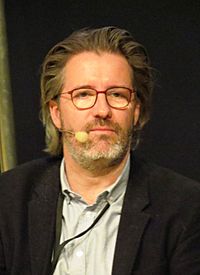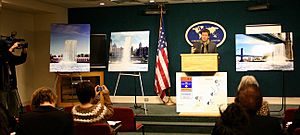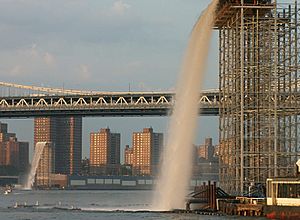Olafur Eliasson facts for kids
Quick facts for kids
Olafur Eliasson
|
|
|---|---|

Olafur in 2015
|
|
| Born |
Ólafur Elíasson
5 February 1967 (age 58) Copenhagen, Denmark
|
| Nationality | Danish–Icelandic |
| Known for | Installation art |
Olafur Eliasson (Icelandic: Ólafur Elíasson; born 5 February 1967) is a famous artist from Iceland and Denmark. He is known for creating sculptures and large art installations. He often uses simple materials like light, water, and even air temperature to make his art special and give viewers a unique experience.
In 1995, Olafur started his own place called Studio Olafur Eliasson in Berlin, Germany. It's like a special lab where he explores ideas about space and art. Later, in 2014, he teamed up with architect Sebastian Behmann to create Studio Other Spaces, which focuses on art and architecture projects.
Olafur represented Denmark at a big art show called the 50th Venice Biennale in 2003. That same year, he created a very famous artwork called The Weather Project at the Tate Modern museum in London. Many people say it was a huge moment in modern art.
Olafur has also worked on many public art projects. These include Green river, where he temporarily dyed rivers green in different cities. He also helped design the Serpentine Gallery Pavilion in London in 2007 and created The New York City Waterfalls in 2008. He even designed the trophy for the Breakthrough Prize, which looks like a toroid (a donut shape) and connects art with science.
Olafur taught art at the Berlin University of the Arts from 2009 to 2014. Since 2014, he has also been a professor at the Alle School of Fine Arts and Design in Ethiopia. His main art studio is in Berlin.
Contents
- Life and Artistic Journey
- Famous Artworks and Projects
- Beauty (1993)
- Ventilator Pieces
- The Weather Project
- Light Installations
- Green River
- Riverbed
- Iceland Photographs
- Your Black Horizon
- Your Mobile Expectations: BMW H2R Project
- The New York City Waterfalls
- The Parliament of Reality
- Colour Experiment Paintings (2009–)
- Harpa
- Your Rainbow Panorama
- Moon
- Contact
- Ice Watch Series
- Vertical Panorama Pavilion (2022)
- Other Projects
- Exhibitions
- Collections
- Awards
- Personal Life
- See also
Life and Artistic Journey
Early Life and Learning
Olafur Eliasson was born in Copenhagen, Denmark, in 1967. His parents moved there from Iceland. His father was a cook, and his mother was a seamstress. When he was 8, his parents separated. He lived with his mother and stepfather, but spent summers and holidays in Iceland with his father, who was an artist.
When Olafur was 15, he had his first art show in Denmark, displaying drawings. But he actually thought his "break-dancing" in the mid-1980s was his first real art! He and two friends formed a group called the Harlem Gun Crew. They performed for four years and even won the Scandinavian championship.
Olafur studied at the Royal Danish Academy of Fine Arts from 1989 to 1995. In 1990, he traveled to New York and worked as an assistant for another artist. There, he also read about how people see and understand things.
Starting His Art Career
Olafur finished art school in 1995. He had already moved to Berlin in 1993, where he set up his art studio. His studio has moved a few times, but it's still in Berlin.
In 1996, Olafur started working with Einar Thorsteinn, an architect who was an expert in geometry. They created a large stainless-steel dome that looked like it was growing from the ground. Thorsteinn's knowledge of shapes and space has greatly influenced Olafur's art, especially his geometric lamps and tunnels.
Olafur often works with other experts, like architects and writers. His studio in Berlin is like a big workshop with a team of architects, engineers, and assistants. They all work together to create his amazing artworks. Olafur is inspired by other artists like Bruce Nauman, James Turrell, and Robert Irwin.
As a professor, Olafur started the Institute for Spatial Experiments (IfREX) in 2009, right inside his studio. He has also been recognized as one of the "green artists" who care about climate change.
Famous Artworks and Projects
Beauty (1993)
Beauty is a simple but powerful water installation. It uses spotlights to create a rainbow effect. People who have seen it say it reminds them of the delicate beauty of nature.
Ventilator Pieces
Some of Olafur's early works involve electric fans hanging from the ceiling. In Ventilator (1997), a fan swings around, rotating on its own. Another piece, Quadrible light ventilator mobile (2002–2007), uses a searchlight and four fans to move air and light around a room. These works play with how we experience space and movement.
The Weather Project
The Weather Project was a huge hit at London's Tate Modern museum in 2003. It filled the massive Turbine Hall with a special atmosphere.
Olafur used humidifiers to make a fine mist in the air, like clouds. He also created a giant glowing semicircle that looked like the sun. The ceiling was covered with a huge mirror, so visitors could see themselves as tiny shadows against the orange light. Many people lay on their backs, waving their hands and legs, feeling like they were floating in the sky.
This artwork was incredibly popular, attracting two million visitors in six months. It's still one of his most famous pieces and is considered a very important artwork of the 21st century.
Light Installations
Olafur loves to experiment with light. In Room For One Colour (1998), a corridor is lit with yellow lamps, making everything look monochromatic and changing how you see colors. Another work, 360 degrees Room For All Colours (2002), is a round light sculpture where you feel surrounded by intense light, losing your sense of direction.
His later installation, Din blinde passager (Your blind passenger) (2010), is a long tunnel filled with thick fog. You can only see about 1.5 meters in front of you, so you have to use your other senses to find your way. People who have experienced it say it makes them feel alone in the universe, hearing their own heartbeat.
Green River
In 1998, Olafur found a safe, non-toxic powder called uranin, used to find leaks in pipes. He realized it could dye entire rivers a bright fluorescent green. He tested it in the Spree River in Berlin. Then, he started adding the dye to rivers in cities like Moss (Norway), Los Angeles, Stockholm, and Tokyo, always without warning. This project made him famous internationally.
Riverbed
At the Louisiana Museum of Modern Art in Denmark (2014–2015), Olafur created an artwork called Riverbed. He brought natural rocks, dirt, and water into the gallery, turning the space into a landscape. This artwork makes you feel like you're in a real riverbed, but it's also clearly an art installation. It's an experience that uses all your senses, inviting you to explore and think about freedom within a designed space.
Iceland Photographs
Olafur often shows collections of photographs he takes in Iceland. These pictures usually focus on one subject, like volcanoes, hot springs, or isolated huts. He has photographed all of Iceland's bridges and documented a volcanic eruption. He often takes these photos from a small plane, like mapmakers do. When arranged together, they look like the repetitive images by German photographers Bernd and Hilla Becher.
Your Black Horizon
This light installation was shown in Venice, Italy, in 2005. It was a temporary building on an island. Inside, the room was painted black with a thin, continuous line of light at eye-level, dividing the space. It made you feel like you were looking at a distant horizon. The pavilion was later moved to an island in Croatia.
Your Mobile Expectations: BMW H2R Project
In 2007, BMW asked Olafur to create an art car. He took a hydrogen-powered car and replaced its body with a framework of steel bars and mesh. Then, he sprayed about 530 gallons of water onto it over several days, creating layers of ice. The frozen sculpture glows from the inside. It was shown in special temperature-controlled rooms in museums.
The New York City Waterfalls
In 2008, Olafur created four huge man-made waterfalls in New York Harbor. They ranged from 90 to 120 feet tall! This project was a very expensive public art installation, but it was a spectacular sight for everyone in New York.
The Parliament of Reality
This permanent sculpture was opened in 2009 at Bard College in New York. It's inspired by the ancient Icelandic parliament, Althingi, one of the world's first democratic meeting places. Olafur designed it as a spot where students and visitors can gather, relax, discuss ideas, or even have debates. It's an island surrounded by a lake, with trees and wild grasses. On the island, large rocks form an outdoor seating area. A bridge leads to the island, making it feel like you're entering a special forum.
Colour Experiment Paintings (2009–)
For this ongoing series, Olafur studies how colors are made and used. He mixes paints to match every tiny shade of the visible light spectrum. He also explores the work of famous painters like Caspar David Friedrich and J. M. W. Turner, analyzing their use of light and color. In 2023, one of his artworks, Colour experiment no. 114, was used for the cover of a song by musician Peter Gabriel.
Harpa
Olafur helped design the outside of Harpa, a new concert hall and conference center in Reykjavík, Iceland, which opened in 2011. He designed a unique facade (the building's front) made of large, twelve-sided glass and steel bricks. This facade reflects the city life and changes with the sunlight and weather. At night, the glass bricks light up with different colored LED lights, making the building look amazing.
Your Rainbow Panorama
Your Rainbow Panorama is a circular walkway made of glass in every color of the rainbow. It's 150 meters long and sits on top of the ARoS Aarhus Kunstmuseum in Aarhus, Denmark. It opened in May 2011. Visitors can walk through the colorful corridor and get a panoramic view of the city, seeing it through different colored glass. At night, spotlights inside light up the artwork.
Moon
In 2013, Olafur worked with artist Ai Weiwei to create Moon, an online platform. It allows anyone to draw on a digital replica of the moon using their web browser. Olafur described it as a place to "make a mark that matters to you. Make your wish, make your dream." Over 35,000 people participated in the first six weeks.
Contact
From December 2014 to February 2015, Olafur had an exhibition called Contact at the Fondation Louis Vuitton in Paris. The artworks were like a journey through darkness, light, shapes, and reflections. Visitors became part of the experience, exploring how they see and understand space.
Ice Watch Series
The Ice Watch series (2014-2018) aims to raise awareness about climate change. Olafur brought enormous blocks of ice from a fjord in Greenland to cities like Copenhagen (2014), Paris (2015), and London (2018). The ice blocks were placed in a circle and slowly melted. This project was timed with major climate change conferences, showing people the reality of melting glaciers.
Vertical Panorama Pavilion (2022)
This pavilion was built in California in 2022. It's designed for up to 12 guests and is inspired by circular calendars. The roof has 832 colorful panels of recycled glass in 24 colors, supported by 12 steel columns. From a distance, you can only see the beautiful, translucent rainbow roof.
Other Projects
- In 2005–2007, Olafur worked with a violin maker to create a new musical instrument using modern technology.
- In 2006, he designed special lamps called Eye See You for Louis Vuitton store windows. All the money from this project went to a charity Olafur and his wife started to help an orphanage in Ethiopia.
- In 2007, he designed the stage for an opera called Phaedra in Berlin.
- In 2012, Olafur and an engineer founded Little Sun, a company that makes solar-powered LED lamps.
- He was part of the design team for New York's High Line park.
- In 2019, Olafur was named a Goodwill Ambassador by the United Nations Development Programme. He encourages people to take action on climate change and work towards sustainable development goals. He believes it's important to stay positive and hopeful.
Exhibitions
Olafur had his first solo art show in Cologne in 1993. His first major exhibition in the United States, Take Your Time: Olafur Eliasson, was organized by the San Francisco Museum of Modern Art (SFMOMA) from 2007 to 2008. This big show covered his artworks from 1993 to 2007 and included installations, sculptures, and photographs. The exhibition then traveled to other major museums in New York, Dallas, Chicago, and Sydney.
He has also had many other solo exhibitions around the world, including in Paris, Tokyo, and Berlin. His work has been featured in numerous group exhibitions, like the Venice Biennale and the São Paulo Biennial.
From July 2019 to January 2020, the Tate Modern in London held a large exhibition of his work called In real life.
Currently, until July 2025, an exhibition called Open is being held at the MOCA Geffen Contemporary in Los Angeles. It features his light and geometry installations, including a large mirrored sphere.
Collections
Olafur's art can be found in the permanent collections of many famous museums, including:
- Solomon R. Guggenheim Museum, New York
- Museum of Contemporary Art, Los Angeles
- SFMOMA, San Francisco
Awards
Olafur has received many awards for his art:
- In 2004, he won the Nykredit Architecture Prize and the Eckersberg Medal.
- In 2005, he was awarded the Prince Eugen Medal for sculpture.
- In 2006, he received the Crown Prince Couple's Culture Prize and the Austrian Frederick Kiesler Prize.
- In 2007, he won the first Joan Miró Prize.
- In 2013, he and Henning Larsen Architects received the Mies van der Rohe Award for their work on the Harpa Concert Hall in Iceland.
- In 2014, he received the Eugene McDermott Award in the Arts at MIT, which is given to artists who show great promise for future creative work.
In June 2013, the President of Iceland visited Olafur's studio in Berlin.
A documentary film about Olafur, called Domingo, was released in 2014.
Personal Life
In 2003, Olafur married Marianne Krogh Jensen, an art historian. They adopted their son in 2003 and their daughter in 2006, both from Ethiopia. Olafur and Marianne are no longer married. Olafur currently lives and works in Berlin. He speaks Icelandic, Danish, German, and English. His younger half-sister, Victoria Eliasdottir, is a chef.
See also
 In Spanish: Olafur Eliasson para niños
In Spanish: Olafur Eliasson para niños
- List of exhibitions by Olafur Eliasson





